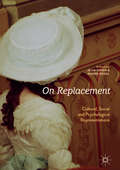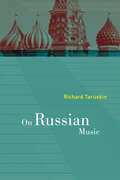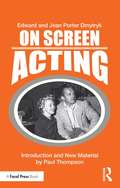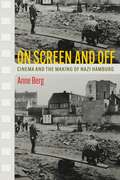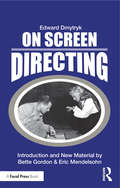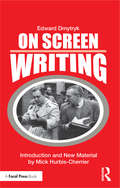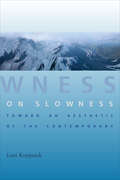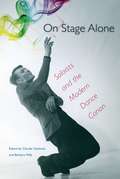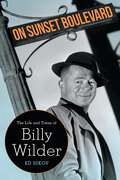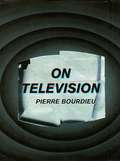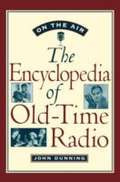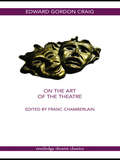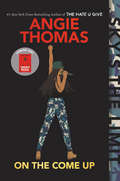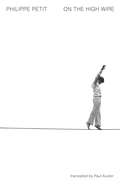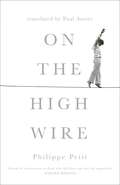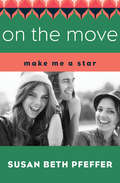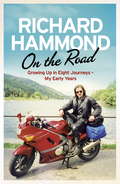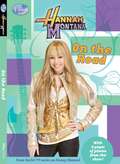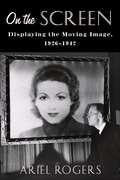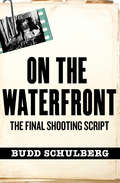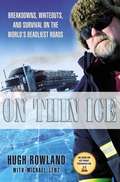- Table View
- List View
On Replacement: Cultural, Social and Psychological Representations
by Jean Owen Naomi SegalThis book is an interdisciplinary study of the human drama of replacement. Is one’s irreplaceability dependent on surrounding oneself by a replication of others? Is love intrinsically repetitious or built on a fantasy of uniqueness? The sense that a person’s value is blotted out if someone takes their place can be seen in the serial monogamy of our age and in the lives of ‘replacement children’ – children born into a family that has recently lost a child, whom they may even be named after. The book investigates various forms of replacement, including AI and doubling, incest and bedtricks, imposters and revenants, human rights and ‘surrogacy’, and intertextuality and adaptation. The authors highlight the emotions of betrayal, jealousy and desire both within and across generations. On Replacement consists of 24 essays divided into seven sections: What is replacement?, Law & society, Wayward women, Lost children, Replacement films, The Holocaust and Psychoanalysis. The book will appeal to anyone engaged in reading cultural and social representations of replacement.
On Russian Music
by Richard TaruskinOver the past four decades, Richard Taruskin's publications have redefined the field of Russian music study. This volume gathers thirty-six essays on composers ranging from Bortnyansky in the eighteenth century to Tarnopolsky in the twenty-first, as well as all of the famous names in between. Some of these pieces, like the ones on Chaikovsky's alleged suicide and on the interpretation of Shostakovich's legacy, have won fame in their own right as decisive contributions to some of the most significant debates in contemporary musicology. An extensive introduction lays out the main issues and a justification of Taruskin's approach, seen both in the light of his intellectual development and in that of the changing intellectual environment, which has been particularly marked by the end of the cold war in Europe.
On Screen Acting: An Introduction to the Art of Acting for the Screen (Edward Dmytryk: On Filmmaking)
by Jean Porter Dmytryk Edward DmytrykWith On Screen Acting, director Edward Dmytryk and actress Jean Porter Dmytryk offer a lively dialogue between director and actress about the principles and practice of screen acting for film and television. Informal and anecdotal in style, the book spans auditioning, casting, rehearsal, and on-set techniques, and will be of interest to both aspiring and working actors and directors. <p><p>Originally published in 1984, this reissue of Dmytryk’s classic acting book includes a new critical introduction by Paul Thompson, as well as chapter lessons, discussion questions, and exercises.
On Screen and Off: Cinema and the Making of Nazi Hamburg
by Anne BergOn Screen and Off shows that the making of Nazism was a local affair and the Nazi city a product of more than models and plans emanating from Berlin. In Hamburg, film was key in turning this self-styled "Gateway to the World" into a "Nazi city." The Nazi regime imagined film as a powerful tool to shape National Socialist subjects. In Hamburg, those very subjects chanced upon film culture as a seemingly apolitical opportunity to articulate their own ideas about how Nazism ought to work. Tracing discourses around film production and film consumption in the city, On Screen and Off illustrates how Nazi ideology was envisaged, imagined, experienced, and occasionally even fought over.Local authorities in Hamburg, from the governor Karl Kaufmann to youth wardens and members of the Hamburg Film Club, used debates over cinema to define the reach and practice of National Socialism in the city. Film thus engendered a political space in which local activists, welfare workers, cultural experts, and administrators asserted their views about the current state of affairs, articulated criticism and praise, performed their commitment to the regime, and policed the boundaries of the Volksgemeinschaft. Of all the championed "people's products," film alone extended the promise of economic prosperity and cultural preeminence into the war years and beyond the city's destruction. From the ascension of the Nazi regime through the smoldering rubble, going to the movies grounded normalcy in the midst of rupture.
On Screen Directing (Edward Dmytryk: On Filmmaking)
by Edward DmytrykWith On Screen Directing, renowned filmmaker Edward Dmytryk distills a lifetime of experience as a director into a dozen short essays on the craft of directing, spanning every stage of the filmmaking process, from screenwriting, preproduction, and casting to set design, postproduction, and promotion. <p><p>Originally published in 1984, this reissue of Dmytryk’s classic directing book includes a new critical introduction by Bette Gordon and Eric Mendelsohn, as well as chapter lessons, discussion questions, and exercises.
On Screen Writing (Edward Dmytryk: On Filmmaking)
by Edward DmytrykWith On Screen Writing, director Edward Dmytryk offers a clear, methodical overview of the needs, practices, and problems of screenwriting, including extensive coverage of adaptation. Written In an informal, anecdotal style and using script examples from Hollywood classics, Dmytryk presents a practical set of principles for writing engaging, filmable screenplays. <p><p>Originally published in 1985, this reissue of Dmytryk’s classic screenwriting book includes a new critical introduction by Mick Hurbis-Cherrier, as well as chapter lessons, discussion questions, exercises, and a glossary.
On Slowness: Toward an Aesthetic of the Contemporary (Columbia Themes in Philosophy, Social Criticism, and the Arts)
by Lutz KoepnickSpeed is an obvious facet of contemporary society, whereas slowness has often been dismissed as conservative and antimodern. Challenging a long tradition of thought, Lutz Koepnick instead proposes we understand slowness as a strategy of the contemporary—a decidedly modern practice that gazes firmly at and into the present's velocity.As he engages with late twentieth- and early twenty-first-century art, photography, video, film, and literature, Koepnick explores slowness as a critical medium to intensify our temporal and spatial experiences. Slowness helps us register the multiple layers of time, history, and motion that constitute our present. It offers a timely (and untimely) mode of aesthetic perception and representation that emphasizes the openness of the future and undermines any conception of the present as a mere replay of the past. Discussing the photography and art of Janet Cardiff, Olafur Eliasson, Hiroshi Sugimoto, and Michael Wesely; the films of Peter Weir and Tom Tykwer; the video installations of Douglas Gordon, Willie Doherty, and Bill Viola; and the fiction of Don DeLillo, Koepnick shows how slowness can carve out spaces within processes of acceleration that allow us to reflect on alternate temporalities and durations.
On Slowness
by Lutz KoepnickA counterintuitive take on the deceleration of time and its function in contemporary art and culture.
On Stage Alone: Soloists and the Modern Dance Canon
by Claudia Gitelman Barbara PalfySoloists ignited the modern dance movement and have been a source of its constant renewal. Pioneering dancers such as Loïe Fuller, Isadora Duncan, Ruth St. Denis, and Maud Allan embodied the abstraction and individuality of the larger modernist movement while making astounding contributions to their art. Nevertheless, solo dancers have received far less attention in the literature than have performers and choreographers associated with large companies.In On Stage Alone, editors Claudia Gitelman and Barbara Palfy take an international approach to the solo dance performance. The essays in this standout volume broaden the dance canon by bringing to light modern dance soloists from Europe, Asia, and the Americas who have shaped significant, sustained careers by performing full programs of their own choreography.Featuring in-depth examinations of the work of artists such as Michio Ito, Daniel Nagrin, Ann Carlson, and many others, On Stage Alone reveals the many contributions made by daring solo dancers from the dawn of the twentieth century through today. In doing so, it explores many important statements these soloists made regarding topics such as freedom, personal space, individuality, and gender in the modern era.
On Stage & In Shadows: a career memoir
by Marie Wallace"Broadway veteran Marie Wallace provides an intimate. informative, often humorous look behind the scenes of some stage classics. And her Dark Shadows fans will learn fun new facts about the Gothic soap opera."
On Sunset Boulevard: The Life and Times of Billy Wilder
by Ed SikovOn Sunset Boulevard, originally published in 1998, describes the life of acclaimed filmmaker Billy Wilder (1906-2002), director of such classics as Sunset Boulevard, The Lost Weekend, The Seven Year Itch, and Sabrina. This definitive biography takes the reader on a fast-paced journey from Billy Wilder's birth outside of Krakow in 1906 to Vienna, where he grew up, to Berlin, where he moved as a young man while establishing himself as a journalist and screenwriter, and triumphantly to Hollywood, where he became as successful a director as there ever was.Double Indemnity, Sunset Boulevard, Some Like It Hot, and The Apartment"Wilder's cinematic legacy is unparalleled. Not only did he direct these classics and twenty-one other films, he co-wrote all of his own screenplays. Volatile, cynical, hilarious, and driven, Wilder arrived in Hollywood an all-but-penniless refugee who spoke no English. Ten years later he was calling his own shots, and he stayed on top of the game for the next three decades. Wilder battled with Humphrey Bogart, Marilyn Monroe, Bing Crosby, and Peter Sellers; kept close friendships with William Holden, Audrey Hepburn, Jack Lemmon, and Walter Matthau; amassed a personal fortune by way of blockbuster films and shrewd investments in art (including Picassos, Klees, and Mir's); and won Oscars--yet Wilder, ever conscious of his thick accent, always felt the sting of being an outsider.On Sunset Boulevard traces the course of a turbulent but fabulous life, both behind the scenes and on the scene, from Viennese cafes and Berlin dance halls in the twenties to the Hollywood soundstages of the forties and the on-location shoots of the fifties and sixties. Crammed with Wilder's own caustic wit, On Sunset Boulevard reels out the story of one of cinema's most brilliant and prolific talents.
On Television
by Pierre BourdieuBourdieu had long been concerned with the role of television in cultural and political life when he bypassed the political and commercial control of the television networks and addressed his country's viewers from the television station of the College de France. "On Television," which expands on that lecture, not only describes the limiting and distorting effect of television on journalism and the world of ideas, but offers the blueprint for a counterattack.
On the Air: The Encyclopedia of Old-Time Radio
by John DunningNow long out of print, John Dunning's Tune in Yesterday was the definitive one-volume reference on old-time radio broadcasting. Now, in On the Air, Dunning has completely rethought this classic work, reorganizing the material and doubling its coverage to provide a richer and more informative account of radio's golden age. Here are some 1,500 radio shows presented in alphabetical order. The great programs of the '30s, '40s, and '50s are all here--Amos & Andy, Fibber Me Gee and Molly, The Lone Ranger, Major Bowes' Original Amateur Hour, and The March of Time, to name only a few. For each, Dunning provides a complete broadcast history, with the time- slot, the network, and the name of the show's sponsors. He lists major cast members, announcers, producers, directors, writers, and sound effects people-even the show's theme song. There are also umbrella entries, such as "News Broadcasts," which features an engaging essay on radio news, with capsule biographies of major broadcasters like Lowell Thomas and Edward R. Murrow. Equally important, Dunning provides a fascinating account of each program, taking us behind the scenes to capture the feel of the performance, such as the ghastly sounds of Lights Out (a horror drama where heads rolled and bones crunched), and providing engrossing biographies of the main people involved in the show. A wonderful read for everyone who loves old-time radio, On the Air is a must purchase for all radio hobbyists and anyone interested in 20th-century American history. It is an essential reference work for libraries and radio stations. JOHN DUNNING is a popular mystery novelist, author of The Bookman's Wake and Booked to Die. He lives in Aurora, Colorado.
On the Art of the Theatre
by Edward Gordon CraigFirst published in 1911, On the Art of the Theatre remains one of the seminal texts of theatre theory and practice. Actor, director, designer and pioneering theorist, Edward Gordon Craig was one of twentieth century theatre’s great modernisers. Here, he is eloquent and entertaining in expounding his views on the theatre; a crucial and prescient contribution that retains its relevance almost a century later. This reissue contains a wealth of new features: a specially written Introduction and notes from editor Franc Chamberlain an updated bibliography further reading. Controversial and original, On the Art of the Theatre stands as one of the most influential books on theatre of the twentieth century.
On the Come Up
by Angie ThomasSixteen-year-old Bri wants to be one of the greatest rappers of all time. Or at least win her first battle. As the daughter of an underground hip hop legend who died right before he hit big, Bri’s got massive shoes to fill. <p><p> But it’s hard to get your come up when you’re labeled a hoodlum at school, and your fridge at home is empty after your mom loses her job. So Bri pours her anger and frustration into her first song, which goes viral…for all the wrong reasons. <p> Bri soon finds herself at the center of a controversy, portrayed by the media as more menace than MC. But with an eviction notice staring her family down, Bri doesn’t just want to make it—she has to. Even if it means becoming the very thing the public has made her out to be. <p> Insightful, unflinching, and full of heart, On the Come Up is an ode to hip hop from one of the most influential literary voices of a generation. It is the story of fighting for your dreams, even as the odds are stacked against you; and about how, especially for young black people, freedom of speech isn’t always free. <P><b>A New York Times Bestseller</b>
On the High Wire
by Philippe Petit“On the High Wire is fascinating to read. You will learn about the man, his work, his passion, his tenacity and lucidity” (Marcel Marceau) In this poetic handbook, written when he was just twenty-three, the world-famous high-wire artist Philippe Petit offers a window into the world of his craft. Petit masterfully explains how preparation and self-control contributed to such feats as walking between the towers of Notre Dame and the World Trade Center. Addressing such topics as the rigging of the wire, the walker’s first steps, his salute and exercises, and the work of other renowned high-wire artists, Petit offers us a book about the ecstasy of conquering our fears and reaching for the stars.
On the High Wire (W&N Essentials)
by Philippe PetitIn this poetic handbook, written when he was just twenty-three, the world-famous high-wire artist Philippe Petit offers a window into the world of his craft. Petit masterfully explains how preparation and self-control contributed to such feats as walking between the towers of Notre Dame and the World Trade Center. Addressing such topics as the rigging of the wire, the walker's first steps, his salute and exercises, and the work of other renowned high-wire artists, Petit offers us a book about the ecstasy of conquering our fears and reaching for the stars.
On the Move (Make Me a Star #4)
by Susan Beth PfefferOn their first hiatus from TV's cool new prime-time series, Bill, Miranda, TJ, Alison, Rafe, and Molly are looking forward to getting back to the real world--but will they ever be normal teenagers again? The first season of Hard Time High is over, and Bill, Miranda, TJ, Alison, Rafe, and Molly have three whole weeks to themselves. It's back to high school for Bill--no more cramming in homework between takes--and spending quality time with his girlfriend, Calista. After years of acting on the road, Molly can't wait to share a real Thanksgiving with Miranda and her family in New England. Between a commitment to a holiday parade and a spread for a fashion magazine, Alison won't have much time for herself. Rafe is taking his parents on an all-expenses-paid trip to Hawaii. And TJ's headed to Indiana to visit his mom. Then it's on to New York to meet his East Coast fan club before he strikes out for London and Paris. But it seems that Rafe, Molly, and TJ are keeping major, scandal-worthy secrets. In between reuniting with old friends and doing normal stuff like attending football games, they're all trying to cope with their new celebrity and wondering what the new season has in store.
On the Road: Growing up in Eight Journeys - My Early Years
by Richard HammondON THE ROAD: GROWING UP IN EIGHT JOURNEYS - MY EARLY YEARS is a new form of autobiography, in which TOP GEAR presenter Richard Hammond tells the story of his early life through a series of significant driving episodes. He's a child in the back seat of Dad's car on the way to the seaside in Weston-Super-Mare. He's on his first bike, a red one, in Solihull, then on his first motorcycle, a Honda MTX50. He's at the wheel of his first car (and in the back with his first girlfriend). He is driving a furniture delivery van as part of his first job in and around Ripon. Now he is showing off with a friend, risking everything. ON THE ROAD is an emotional road map in which each chapter has its own registration number, and its own distinctive interior. Most importantly, each chapter sets off and arrives. ON THE ROAD surges on to its destination, reversing or moving quickly through the gears, reliving the central episodes and conflicts of Richard's life. Every chapter is a stage in a longer journey. Although there are precious few road-rage monologues against four-wheel drivers and men in vests in white vans, Richard Hammond's readers will quickly recognise the funny self-deprecating and balanced ease that has made him one of Britain's best-loved writers and television presenters.
On the Road: Growing up in Eight Journeys - My Early Years
by Richard HammondON THE ROAD: GROWING UP IN EIGHT JOURNEYS - MY EARLY YEARS is a new form of autobiography, in which TOP GEAR presenter Richard Hammond tells the story of his early life through a series of significant driving episodes. He's a child in the back seat of Dad's car on the way to the seaside in Weston-Super-Mare. He's on his first bike, a red one, in Solihull, then on his first motorcycle, a Honda MTX50. He's at the wheel of his first car (and in the back with his first girlfriend). He is driving a furniture delivery van as part of his first job in and around Ripon. Now he is showing off with a friend, risking everything.ON THE ROAD is an emotional road map in which each chapter has its own registration number, and its own distinctive interior. Most importantly, each chapter sets off and arrives. ON THE ROAD surges on to its destination, reversing or moving quickly through the gears, reliving the central episodes and conflicts of Richard's life. Every chapter is a stage in a longer journey. Although there are precious few road-rage monologues against four-wheel drivers and men in vests in white vans, Richard Hammond's readers will quickly recognise the funny self-deprecating and balanced ease that has made him one of Britain's best-loved writers and television presenters.
On the Road (Disney's Hannah Montana #14)
by Kitty RichardsSeries Description: Miley Stewart looks like a regular girl-next-door, but when the lights go down, Miley is teen pop sensation Hannah Montana! Off stage, Miley wants her life to be as normal as possible, so only a few people know the truth about her dual identity. But keeping that secret is harder than Miley ever thought it would be. Hannah Montana #14: On the Road. Miley is totally disappointed! Her dad canceled Hannah Montana's European concert tour because she is flunking biology. But if she can ace her midterm, Hannah's tour is back on! Miley is determined to go to Europe, so she creates song and dance routines as study techniques for the test. Will Miley's preparations earn her an A, or will she be left singing the blues? Plus, when Miley's dad forbids her to travel alone for a Hannah Montana charity concert, she decides to take matters into her own hands-and goes anyway!
On the Screen: Displaying the Moving Image, 1926–1942 (Film and Culture Series)
by Ariel RogersToday, in a world of smartphones, tablets, and computers, screens are a pervasive part of daily life. Yet a multiplicity of screens has been integral to the media landscape since cinema’s golden age. In On the Screen, Ariel Rogers rethinks the history of moving images by exploring how experiments with screen technologies in and around the 1930s changed the way films were produced, exhibited, and experienced.Marshalling extensive archival research, Rogers reveals the role screens played at the height of the era of “classical” Hollywood cinema. She shows how filmmakers, technicians, architects, and exhibitors employed a variety of screens within diverse spaces, including studio soundstages, theaters, homes, stores, and train stations. Far from inert, screens served as means of structuring mediated space and time, contributing to the transformations of modern culture. On the Screen demonstrates how particular approaches to the use of screens traversed production and exhibition, theatrical and extratheatrical practice, mainstream and avant-garde modes, and even cinema and television. Rogers’s history challenges conventional narratives about the novelty of the twenty-first-century multiscreen environment, showing how attention to the variety of historical screen practices opens up new ways to understand contemporary media.
On the Waterfront: The Final Shooting Script (Plays For Performance Ser.)
by Budd SchulbergSchulberg&’s Academy Award–winning screenplay about ex-boxer and dock worker Terry Malloy, whose talent made him a contender and whose courage will make him a heroThe film On the Waterfront garnered eight Oscars; the leading role of Terry Malloy was perhaps Marlon Brando&’s tour de force. But none of these achievements would have been possible without the explosive, inspired script written by Budd Schulberg. The story of stevedores sweating and dying for a corrupt, Mob-run union, and one former boxer&’s quixotic fight for dignity, stands among the most iconic narratives of American cinema. Deeply influenced by Schulberg&’s own reporting on New York and New Jersey crime families, unions, and the boxing world, as well as on earlier reporting by Malcolm Johnson, this screenplay represents a singular confluence of American artistry and political history. This ebook features an illustrated biography of Budd Schulberg including rare images and never-before-seen documents from the author&’s estate.
On Thin Ice: Breakdowns, Whiteouts, and Survival on the World's Deadliest Roads
by Michael Lent Hugh RowlandYou've watched him battle the odds on History's Ice Road Truckers. Now read Hugh "The Polar Bear" Roland's own storm-by-storm account of surviving and conquering the infamous ice roads of the Arctic. Join Hugh in the front seat of his truck as he shares his most chilling, adrenaline-fueled tales of the world's most dangerous job. Every year, a fleet of truckers travels beyond the northern equatorial line to the Arctic Circle, battling subzero temperatures and perilous conditions. Though treacherous, it is a region heavily endowed with natural resources. Locating this abundance of natural gas, conflict-free diamonds, and gold is relatively easy; extracting and transporting these goods is another matter entirely. The elite truckers chosen to deliver materials vital to these efforts spend two months traveling distances greater than Western Europe on naturally formed roads of ice that is only sixteen inches thick. It is one of the most dangerous jobs in the world. For more than twenty years, Hugh Rowland has survived the ice roads like none other. Each year when the temperature plummets, Rowland leaves his family in Vancouver, Canada, to drive 1,900 miles to Yellowknife, where he will begin his odyssey. Facing the threat of perilous avalanches, hundred-foot cliffs, and the ever-present danger of cracking through the ice, Hugh must push himself to the limit. The payoff is sweet, but Rowland isn't in it just for the money; he is driven by the camaraderie, the call to adventure, and the chance to battle the odds year after year. From the first snowstorm to the final thaw, On Thin Ice traces the history of ice road trucking, chronicles Rowland's preparation for the trek, and follows him through his perilous journey along the infamous ice roads. Take a ride with Rowland as he recounts tales of epic breakdowns and breathtaking heroism that are just a daily part of the job. In this classic battle of man and machine versus cruelest nature, only the strong will survive to see their payday, their families, and the chance to do it all over again . . . on thin ice. WHEN HELL FREEZES OVER . . . "You've never experienced winter until you've lived through one in the far north. It starts in October and doesn't let up until mid-April. The temperatures drop to minus 70, with winds blowing 60 miles an hour. At that temperature, you throw a pot of boiling water or coffee into the air and it will instantly vaporize and turn into snow. It's cold as hell, but it's also full of riches: silver, gold, uranium, diamonds, and oil worth tens of billions of dollars. Locating these treasures in the frozen tundra is the easy part. Getting them out of the ground and bringing them from the frozen wasteland to civilization is a lot tougher. That's my job." --From Ice Road Truckers
